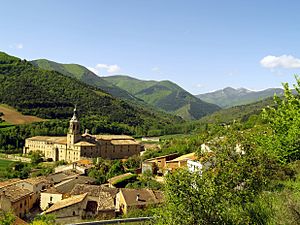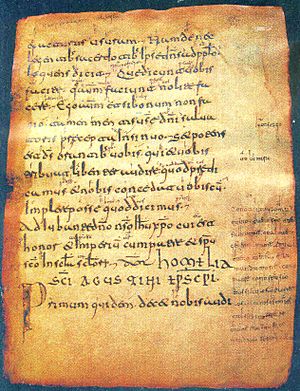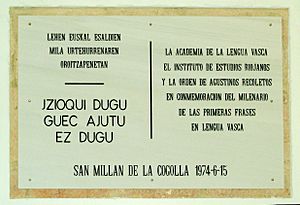Glosas Emilianenses facts for kids
The Glosas Emilianenses are special notes written a very long time ago, around the 10th or 11th century. These notes were added to an older Latin book from the 9th century. They are super important because they show us some of the earliest examples of writing in languages similar to modern Spanish and Basque.
An unknown monk wrote these notes. He probably lived at the Suso monastery, which is one of two monasteries in San Millán de la Cogolla. This area is now in La Rioja, Spain.
The monk wrote in three different languages:
- A simpler version of Latin
- A medieval form of a Hispanic Romance language. This language is often thought to be an early form of Spanish or Navarro-Aragonese.
- Medieval Basque
These last two languages were the everyday languages spoken by people in that area.
For a long time, people thought the Glosas Emilianenses contained the very first examples of written Spanish. However, in 2010, the Real Academia Española (the official group for the Spanish language) said that even older Spanish writings were found in the Cartularies of Valpuesta. These documents are from the 9th century and come from the province of Burgos.
Contents
What are the Glosas Emilianenses?
The book where these notes were found is called Aemilianensis 60. It's a collection of several old books, including Verba seniorum and Sermones beati Augustini.
This important book was kept safe in the library at the Yuso monastery. In the early 1900s, a language expert named Ramón Menéndez Pidal realized how special it was. Since 1951, the book has been kept at the Real Academia de la Historia in Madrid.
Romance Language Notes
Some of the notes are about grammar. Others are additions to the text, and some are explanations of words.
There's a discussion about whether the Romance language in the notes is an early form of Castilian (which became Spanish) or Aragonese. Recent studies suggest it's more like Aragonese. It can be tricky to classify these old languages. Some experts say it's too early to give them specific dialect names before the 1200s. They prefer to call it an "unspecialized informal Ibero-Romance" language.
Even with this debate, San Millán de la Cogolla was known as the "birthplace of the Spanish language." This reputation helped it become a World Heritage Site in 1997.
Longest Note and Its Meaning
The longest note is on page 72 of the old book. A Spanish language expert, Dámaso Alonso, called this short prayer "the first cry of the Spanish language."
Here is the old text and what it means in English:
Old text
Con o aiutorio de nuestro
dueno dueno χρο, dueno
ſalbatore, qual dueno
yet ena honore et qual
duenno tienet ela
mandatione con o
patre con o ſpu ſco
en oſ ſieculoſ de lo ſiecu
loſ. facanoſ dſ ompeſ
tal serbitio fere ke
denante ela sua face
gaudioſo ſeyamuſ. Amen.
Translation
With the help of our
lord Lord Christ, Lord
Savior, Lord
who is in honor,
Lord that has
command with
the Father, with the Holy Spirit
for ever and ever.
God Omnipotent, make us
do such a service that
before His face
joyful we are. Amen.
Comparing Words
This table shows some words from the Glosas, and how they look in modern Aragonese, Spanish, and Latin.
| Glosas | Aragonese | Spanish | Latin | Translation to English |
|---|---|---|---|---|
| de loſ (delo) | de los, d’os | de los | < DE ILLOS | of the (masculine, plural article) |
| ela | a, l’ | la | < ILLA | the (feminine, singular article) |
| ena, enoſ | en a, en os | en la, en los | < IN ILLAM, IN ILLOS | in the (feminine, singular and masculine, plural articles) |
| fere | fer | hacer | < FACERE | to make |
| ſieculoſ | sieglos | (sieglos >) siglos | < SAECULU | centuries |
| yet | ye | es | < EST | is (3rd person, singular, verb "to be") |
Basque Language Notes
The Aemilianensis 60 book is also famous for having the earliest known notes in the Basque language.
Out of about one thousand notes in the book, only two are in Basque. These are very short, just six words in total. You can see them on a plaque at the Yuso monastery. Some people also think that the monk who wrote the notes knew Basque well, because some of his Romance notes show signs of Basque influence.
Images for kids
-
Map showing the major territorial situation around the year 1000 AD. Almanzor (Al-Mansur) campaigns and "razzias" to Christian territory. Green: Caliphate of Cordoba. Dark green: conquests of Almanzor. Khakis: Christian kingdoms.
See also
 In Spanish: Glosas Emilianenses para niños
In Spanish: Glosas Emilianenses para niños
- Spanish language
- Monasteries of San Millán de la Cogolla
- Navarro-Aragonese dialect
- Early Spanish Literature and the Middle Ages
- Basque language
- Wikisource: Glosas Emilianenses






